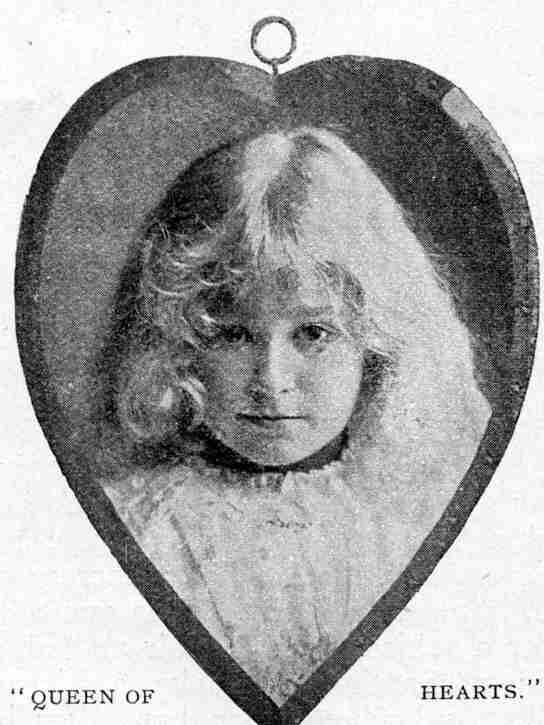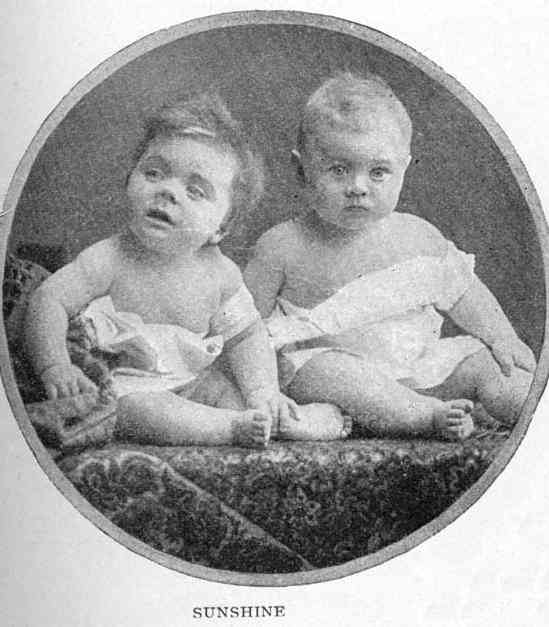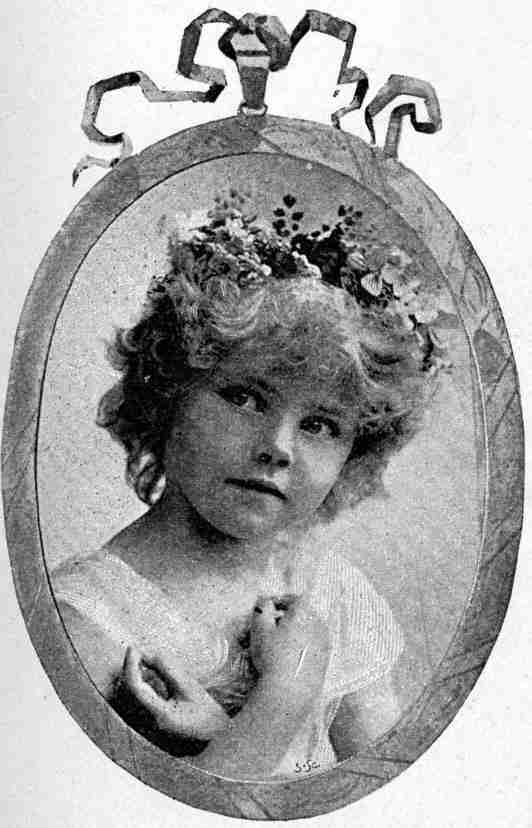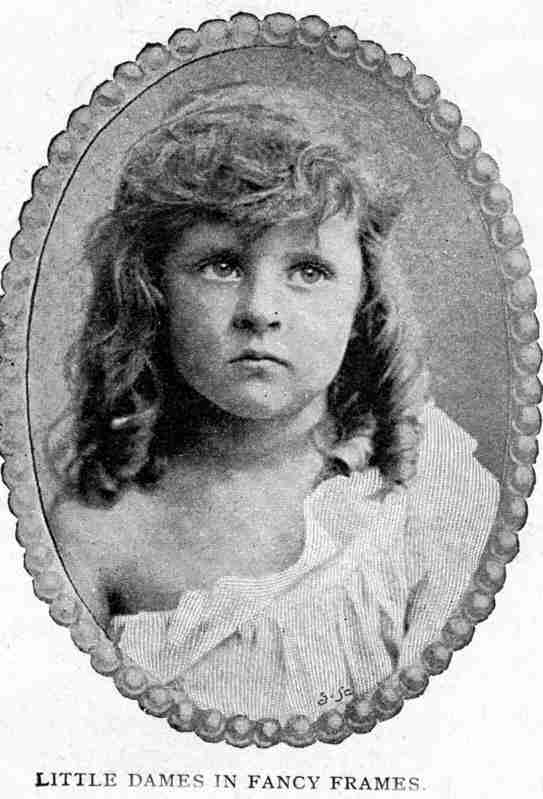
W.J. Byrne "Little darlings: Half a million photographs of children"

Figure 1.--We note a fascinating article, "Little Darlings" about Byrne that appeared in The Harmsworth Magazine (Monthly Pictorial ) Volume 1 - 1898-99 in which Byrne's career as a child photographer, including the technique he used to photograph thousands of children in his studio, is described.
|
We note a fascinating article, "Little Darlings" about Byrne that appeared in The Harmsworth Magazine (Monthly Pictorial ) Volume 1 - 1898-99 in which Byrne's career as a child photographer, including the technique he used to photograph thousands of children in his studio, is described. The article was written by Somers J. Summers and illustrated with some of W.J. Byrne's favorite portraits. We note the subtitle, "Half a million photographs of children". We know he took thousands of photographs of children. Is it possible that he took 0.5 million? If he had a career of 40 years, that would mean that he took 12,500 photographs annually or 34 every day. Given his appraoch to taking a portrait, this seems an improbably high number. The aricle provides fascinating details on Byrne's career and on his appoach to taking portraits of children.
"Little darlings: Half a million photographs of children"
by Somers J. Summers, Photographic Illustrations by W J. Byrne
LOCKED away in the breast of Mr. W. J. Byrne, the children's photographer is a secret, which, when she has read this article, every mother of children will want to know. Let it be said at once, however, that her curiosity will have to go unsatisfied; Mr. Byrne has his secret, and wild interviewers cannot drag it from him.
Ability to pose adults gracefully and naturally before the camera is an accomplishment admittedly rare; in the case of children with the difficulties increased tenfold, it must be a gift. It is one thing to dump a subject into a chair and obtain a likeness, and another to make a picture as well.
And when a man has taken half a million photographs of little sitters, in as many poses, he may be held to be something of an authority on the subject. That is Mr. Byrne's record; he is to children what Rosa Bonheur is to animals, save that he uses neither pencils nor brush; he is a veritable artist with the camera. Some of the examples of his skill here seen re-present, it is not difficult to realise, an infinity of painstaking and experimenting, while others tell of patient waiting, followed by considerable alacrity at the moment of a fleeting expression which he desired to preserve. Mr. Byrne's method is very simple; one half of his secret is soon told.

Figure 2.--For the magazine article, Byrne selected many of his more artistic portraits.
|
"Photographing children," he says," is charming work, but it can never be successful so long as the customary relations between them and the photographer exist. They usually enter a studio with much the same sort of feelings as they do a dentist's. They should be made to feel at home before the business side of their visit is reached. Instead of being at once placed in the
'Operating' chair, they should be allowed to wander about, if old enough, at their own sweet wills and in any case become accustomed to their strange surroundings. Wild gesticulations, promises of chocolates, stories of the little bird,' and orders to 'keep like that,' only serve to produce expressions of wonder and fear. Personally I let the child amuse itself with new toys, and either pretend to take no notice, or else join in the game. This may go on for half an hour. Meanwhile, an attendant is quietly focusing an almost concealed camera, and when the child begins to prattle, I wait for an unconscious and happy expression, then snap goes the shutter, and the thing is done.
Every child's face is beautiful to at least one pair of eyes. The features may not be symmetrical, the eyes may be small and dull, but the charm of childhood does not lie entirely in facial beauty. It is the coy smile and the quaint expression that a parent prizes most. And it is these characteristics that a photographer should aim to catch. Mothers often make the mistake of rehearsing the sitting at home. It is even better not to mention the matter in the presence of the little one; it is usually much more satisfactory if the visit is a surprise one as far as the child is concerned. It is also unwise to dress the young sitter in unaccustomed clothes or to warn it to be good. For general work, my rule about posing children is, 'Never pose them at all.'
Mr. Byrne's studios are veritable toyshops, containing everything from a jumping frog to a model of an Atlantic liner. Indeed, Mr. Byrne has given a big firm of toy-dealers a standing order to send anything new that comes in the market. Antiquarians will learn with a pang that the dear old Noah's Ark is going the way of all flesh. British children will have none of it. They refuse to look pleasant for less than a little bicycle with rubber tyres, or a miniature motor-car with real boilers - at least when they go to be photographed.
So much, then, for how Mr. Byrne's "happy" results are produced;-what about his "unhappy" ones. Both are well represented here. Take the first pictures, Sunshine and Shadow. What caused the inquisitive little fellow in the first to find the world all dark and so little of interest in life a few seconds later?
It must have been something wholly unexpected, for it effected much the same change in his companions' countenance. Was it a pin-point gently insinuated between the shoulder blades, or a cold sponge dexterously applied to the little spine?

Figure 3.--This is the "Sunshine" and "Shadow" that Byrne discusses. Here is the "Sunshine" portrait. Click on the image to see the "Shadow" image.
|
That is what mothers would like to know. Mr. Byrne says, with a smile, that it was neither, that the expression was a purely natural development. But will the mothers of England believe him?
There is, too, the case of the little boy gazing so intently into a hand-glass; what did he find hidden in its depths to make him suddenly cast it aside, and turn to where the photographer is presumably standing, with such a look of mingled disappointment and disgust? His discovery was evidently remarkable, for, as will be seen, it had the additional effect of taking his fore-lock out of curl. Again Mr. Byrne is appealed to, and again he smiles and vouchsafes the same reply. And again the mothers of England will have their suspicions.
In photography, as in many another profession, the path of those who would forsake the beaten track does not lie through acacia groves. Many obstacles strew the way. For instance, Mr. Byrne conceived the notion of posing children in a big boot, such as appears in two of the accompanying reproductions. It is a simple-looking boot, yet it took two years to make; that is to say, the day the order was given, and the day it was satisfactorily carried out, were separated by a span of such duration. But much happened in between. First of all Mr. Byrne made a rough design of what he wanted giving the dimensions, etc. and sent it through a friend, to a local boot maker. Perhaps, not anxious to have his idea noised throughout camera-land, Mr. Byrne's instructions were not as explicit as they might be; it was the time of the dynamitard outrages, and the worthy artist in leather grew suspicious. What might his customer want with such a boot? it was most unusual; he had never heard of a man with such a large foot; and why only one boot? He didn't like such peculiar orders, but he would do what he could in the matter; of course it would cost a goodish sum. As to whether the poor man had nightly visions of the strange boot being filled with infernal machines and placed under the House of Commons, and himself charged by the State with aiding and abetting the plot, no reliable information is forthcoming, but certainly, after two months had elapsed he sent word to say that he found the work more difficult than he had anticipated, and that unless the one-legged individual, for whom the boot was apparently intended, could call and be measured in the ordinary way, he must regretfully throw up the job. A carpenter was next tried, but with little more success. The boot actually did come home, after a time, but it was large enough for six children to lose themselves in, instead of comfortably accommodating one. At this stage it occurred to Mr. Byrne that one of the Drury Lane "property" men, used to tailoring for pantomime giants and other unusual creatures, would be able to make a boot a little bit out of the common without being too inquisitive as to its mission in life. So it finally arrived, a beautiful creation, fit for any Brobdingnagian dandy, and redolent of Day and Martin. But Mr. Byrne wanted a dilapidated boot; to save further trouble, however, he proceeded, with the aid of a pocketknife and an old hatchet, to dilapidate it himself.

Figure 4.--.
|
It was much the same with the egg appearing herewith. It was tried in canvas, wood, and papier-mâché before the more serviceable aluminium produced a "lay" that any pantomime bird might be proud of. Both the boot and the egg have done yeoman service since. They have assisted in producing something approaching a thousand photograph-pictures.
When Mr. Byrne had shown that the novel could be blended with the artistic in child photography, would-be imitators were not slow to appreciate the innovation. Photographers wrote from all parts of the country to inquire where Mr. Byrne obtained his "properties" they would like to add duplicates to their own studios. Guileless Mr. Byrne replied in each case- "From America."
It would be as difficult for Mr. Byrne to say how he came to make a speciality of child photography as it would to explain what led him to take .to the camera at all. He practically drifted into both.
"My life," he says, "might almost be described as one long drift. Although I was born in Ireland, I entered the Italian army, for some reason no one, not even myself, has ever been able to explain, when I was fifteen years of age. I fought in the Austro-Franco-Italian campaign of 1859, being one of the only two Britishers engaged in the war. The other was the late Colonel Peard. Like him, I was present at the great battles of Magenta and Solferino, and like him I several times came near ending my career on the plains of Lombardy.
"When the war was over, and there seemed no prospect of another, I drifted away from the colours, back to London, and into the more peaceful occupation of portrait making. Photography was in its infancy in those days; and I can only presume that I took kindly to it because I had always been something of an artist, which was of considerable advantage to me in my new profession. After a while I discovered that I secured happier results with children than was usual, probably because, being naturally fond of them, I devoted more care and attention to them than was customary, for child sitters were rare then, and photographers were apt to regard them as rather bad bargains, notwithstanding the higher fees charged."
It is not surprising to learn that Mr. Byrne has "snapped" nearly all the little English royalties; his studios being located at Richmond in Surrey, he has frequently been summoned to the White Lodge and Windsor Castle, not to mention more distant royal seats. Regarding juvenile princes and princesses, Mr. Byrne has something interesting to say.
"Royal children have charming and simple ways, and it is usually an easy matter to establish friendly relations with them. That once accomplished, photographing always becomes a pleasure. They are just as fond of new toys as other children, just as eager for a romp, frequently more so. Indeed, I have more than once had to 'play soldiers' with some of the Queen's grand-children while waiting for them to reach a sitting-still mood."
Perhaps much of Mr. Byrne's success is due to the fact that photography is not merely his profession; it is his hobby as well. He is constantly devising new and novel poses, both for his private sitters and the child-models he employs. When a mother calls at the studio with her bairn, she is shown numerous bulky volumes, veritable picture galleries of children in almost every conceivable attitude, and invited to choose which she would prefer for her own little ones portrait. Bewildered by such a display, she usually elects to leave the choice to the photographer, and she is invariably wise; for the pose that shows to perfection the characteristic beauty of one child may be quite unsuitable for another.

Figure 5.--
|
A trained eye notices these things as quickly as a practised artist can tell whether a certain bit of scenery is "paint-able" or not. One of Mr. Byrne's child-models must be the most photographed little person in the country, for she has figured in no fewer than two thousand studies. To show the variety of these, a page herewith is devoted to a composite reproduction of the little model in some of her happiest poses. The sweet child, it might be mentioned, is the daughter of Mr. Byrne's laundress.
Mr. Byrne has three Don'ts " for mothers who would secure speaking likenesses of their little ones. Don't let the little one know beforehand that it is going to a studio. Don't dress it in any costume to which it is unaccustomed. Don't endeavour to arrange its hair; this will look better if allowed to fall naturally.
It must not be supposed, however, that the subject of this article is a photographer of children only. Between them, eighty-nine exhibitions in various parts of the world have awarded him something like a quarter of a hundredweight of medals for exhibits of all kinds, while he has also photographed nearly every adult member of our royal family and innumerable celebrities. In this branch of his work, however, Mr. Byrne has to content himself with the artistic, and leave the novel severely alone. For the Prince of Wales, considerate sitter though he is would hardly consent to have himself "caught" in an old boot, or Sir Ellis Ashmead Bartlett, though he does much to amuse his fellow members of Parliament, permit himself to be represented emerging from an aluminium egg. So the "properties" have to he laid aside at times.
"The Queen," says Mr. Byrne, "is one of the best sitters in the world, very rarely moving or spoiling a plate. That abomination of all studios, the headrest, is quite unnecessary in Her Majesty's case. The Prince of Wales takes quite a keen interest in photography himself and when sitting will go to considerable personal trouble in order that the results may be successful. The Prince will get together a royal group where anyone else would fail. The German Emperor is a most genial sitter; but his pose before the camera is apt to be rather stiff, and his expression somewhat stern. Nearly every royal sitter, in fact, has some peculiarity which one finds it one's task to moderate without destroying altogether."
But we are no nearer Mr. Byrne's secret. How were the "unhappy" pictures obtained? Stories are told of fond mothers, waiting in anterooms, being horrified to suddenly hear piercing shrieks proceeding from the studio. Breathlessly they have dashed in, to find Mr. Byrne all smiles, baby all tears. When the proofs came home, the picture showing baby crying was generally voted wonderfully lifelike, even if it was not selected for general distribution.
These strange rumours are referred to. and once again Mr. Byrne is appealed to to withdraw the veil; but yet again he smiles and replies as before. Which reply, it is to be feared, the mothers of England will accept with the customary condiment.
HBC

Navigate the Boys' Historical Clothing Web Site:
[Return to:Main W.J. Byrne page]
[Return to:Main photography posing page]
[Introduction]
[Activities]
[Biographies]
[Chronology]
[Clothing styles]
[Countries]
[Bibliographies]
[Contributions]
[FAQs]
[Glossaries]
[Satellite sites]
[Tools]
[Boys' Clothing Home]
Navigate the Boys' Historical Clothing Web Site:
[Sailor suits]
[Sailor hats]
[Buster Brown suits]
[Eton suits]
[Rompers]
[Tunics]
[Smocks]
[Pinafores]
Created: May 1, 2003
Last updated: May 1, 2003







